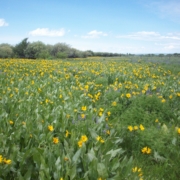Land Trust and longtime Teton Valley family protect scenic farmland and wetland habitat
(March 23, 2021) Teton Regional Land Trust (TRLT) and the Kearsley family recently closed on an 80-acre conservation easement that protects the family’s farm and preserves scenic open space, important wetland habitat, and a portion of two streams within the Teton River watershed. Thanks to the Kearsley family, the iconic scenic view as you enter Teton Valley coming over Pine Creek Pass on Highway 31 will remain that way. The property has been farmed by the Kearsley family for more than 100 years and this will allow them to continue that tradition. David Kearsley worked closely with the Land Trust on the easement. “We appreciate working with TRLT on this project. Funds received through the conservation easement will allow us to keep the property in the family and keep the agricultural usage. There have been five generations of family members who have operated the farm. We look forward to having many more.”
The farm is surrounded by other private lands that were previously protected by conservation easements, making the Kearsley farm an important piece of the conservation puzzle in the Teton Valley’s south end. Significant ecological connections tie the farm to more than 12,340 acres of other TRLT conserved properties in Teton County, as well as a number of other protected properties and public lands. Protecting the wetland and riparian habitats on the farm adds to the conservation of resources that are important for native plants, fish, and wildlife in Teton Valley, including the Greater Sandhill Crane, Long-billed Curlew, and Swainson’s Hawk.
“The Kearsley family is leaving in place a conservation legacy on the landscape that will be intact for many more generations to come.” said Josh Holmes, TRLT’s Land Protection Specialist who led this project to completion, “I can’t thank them enough for that.”
The property’s wetland attributes and the streams that flow through the farm are important contributors to the health and function of the Teton River. These features join other water sources to form the headwaters of the Teton River, which provides habitat for native fish such as the Yellowstone cutthroat trout. The wetland, floodplains, and riparian habitats within the Teton River watershed are vital to the protection of wildlife populations, nutrient cycling, water quality, erosion control, and groundwater discharge. Protection of the Kearsley farm, as well as other lands within the Teton River corridor, is an important part of securing long-term conservation of these precious resources. “Well-managed family farms and ranches play a critical role in protecting and conserving clean water, healthy streams, and a thriving wild fishery in the Teton River Watershed. Friends of the Teton River is thrilled to have been able to help bring funding support to this project”, Amy Verbeten, Executive Director of Friends of the Teton River.
In 2017, TRLT, Friends of the Teton River, and LegacyWorks Group succeeded in acquiring funding from the Natural Resources Conservation Service (NRCS) in Idaho to support conservation work in Teton Valley as part of the NRCS’s Regional Conservation Partnership Program (RCPP). Within the RCPP, the NRCS made federal matching funds available to support conservation easements in Teton Basin through the Agricultural Conservation Easement Program (ACEP). Because the Kearsley farm met the conservation goals of the Teton Basin RCPP by protecting farmland and natural resources beneficial to the health of the Teton River and wildlife species, TRLT was able to secure NRCS support through ACEP.
“NRCS is excited to welcome this parcel into ACEP,” said Wade Brown, Easement Coordinator for NRCS Idaho. “It provides a long-term grazing management program that will, in turn, improve wetland and riparian habitat. That, along with its location within the Teton Basin made it a perfect fit for our easement program.”
Conservation of the Kearsley farm builds on the protection of already conserved valley habitat and working lands that benefits both people and wildlife. For 30 years, the Land Trust has worked with partner organizations and willing landowners to protect more than 37,000 acres in east Idaho through conservation easements and other voluntary conservation options. An ACEP conservation easement allows for farming and ranching of properties, as well as limited residential construction. It also permanently limits the amount and type of future development.



